The 10 Best Film Scores Of 2021
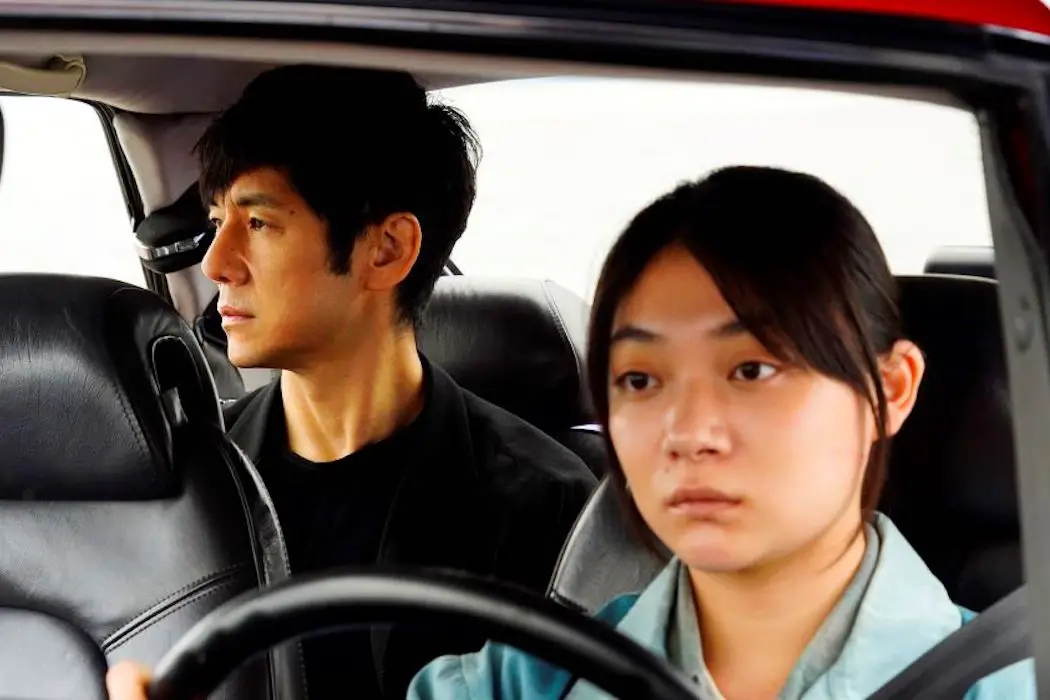
Film critic, Ithaca College graduate, University of St Andrews masters…
Film scores are unquestionably strange beasts. They enliven the material, bring texture to worlds, and personify emotions, and the best ones become eternally tied to a film, property, or a vibe. (No train ride through the countryside is complete without the Lord of the Rings soundtrack.) Most years have standout themes and orchestral juggernauts, but 2021 is a bit of an oddity there. In a year populated by film musicals, brassy Marvel epics, and space adventures, the most iconic theme is probably that of The Power of the Dog, which — hot take inbound — doesn’t even have a great score, but rather boasts a very ear-wormy guitar-and-violin sting from Jonny Greenwood that the film constantly reuses.
Outside of Jane Campion’s New Zealand vistas, 2021 really runs the gamut of film scores, with unusually strong work from Marvel with Shang-Chi and the Legend of the Ten Rings and a terrific Polish medieval flair to Brian D’Oliveira’s The Witcher: Nightmare of the Wolf score. On the other end of the spectrum, Ryuichi Sakamoto’s new work for Minamata and Beckett both feel lacking, save for Minamata’s strong central theme, and the Raya and the Last Dragon and Last Night in SoHo scores from the usually dependable James Newton Howard and Steven Price are kind of nauseating. Like, literally. Listening to SoHo’s searing, pinching, undeveloped string work gave me a headache.
There’s no accounting for taste, of course, but it’s fascinating also to see the kind of music the Oscars consistently recognize — which, this year, encompassed The Power of the Dog, but also Hans Zimmer, whom I’ll complain about later, alongside some stunning work from Nicholas Britell, Germaine Franco and Alberto Iglesias. I always try to listen to as much as possible — this list came out in May because it is the product of over 100 hours of listening to countless scores and watching their associated films… more than enough to completely screw up my Spotify Wrapped stats this year.
Who’s Not Included
Shang-Chi’s score, which I think is probably one of the best Marvel scores, is stunning and grandly operatic, but it’s also composed by Joel P. West, a white dude. For the love of God, I am so sick and tired of white guys being hired to score Asian stories in Hollywood. I complain about this at length elsewhere on the site.
Zimmer, too, is not invited to the party. I frankly don’t understand what people like about the Dune score — it sounds exactly the same as every Zimmer score from the past 20 years. Some tracks, like “Burning Palms,” have nearly identical dense percussion, ominous horns and electro-pulse to his Dark Knight scores. Zimmer also has a team of hundreds of composers he enlists to make these scores by committee, so you can’t even tell how much of Dune is his. It’s an assembly-line product that vaguely serves the story while flaunting enough bagpipes and (questionably adhān-esque) choral sections to convince fans they’re listening to original cues, made expediently enough that Zimmer has the time to bounce among this, The SpongeBob Movie: Sponge on the Run, The Boss Baby: Family Business, No Time To Die, Army of Thieves, The Unforgivable and Around the World in 80 Days in the same year. It’s not just him; according to Vanity Fair, most Hollywood composers rely on teams of uncredited and underpaid contributors, and serious scrutiny should be levied against any composer who cooks up more than several major film scores a year.
10. Hanan Townshend, The Book of Vision
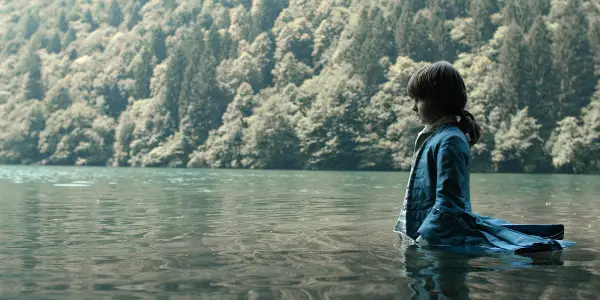
The Book of Vision is Hanan Townshend‘s second major score of the past year — he also did Fathom, a lovely little whale documentary that’s disqualified because, sadly, the score is not available to stream anywhere. So Carlo Hintermann’s Italian-British-Belgian coproduction, The Book of Vision, takes the spot instead, on which Townshend, a Kiwi composer with a knack for ornate environmental compositions, proves his ability to execute lofty prestige orchestrations as well as densely layered atmospheric tracks.
This trippy, time-bending drama about medical research is executive-produced by Terrence Malick, and Hintermann’s first feature was literally a documentary about Malick. Contrary to Townshend‘s work on Malick‘s Knight of Cups, To the Wonder, and Song to Song, he brings here the sense of time opening, a woodwind-heavy, busier sound that incorporates both the expected swells of prestige chamber drama fare as well as frayed rumblings and complex thematic work (there’s even one haunting choral number, “In Your Eyes,” that makes one feel as though they’re about to be murdered by a demon child).
Where The Book of Vision falters in terms of its performances and sound design, Townshend picks up the slack on the score. In a bad film, there can still be a great score, as many of the entries on this list may testify to, and Townshend’s musical flair is such that even a project as problematic and harried as The Book of Vision may be elevated to profundity by his work.
Rather than opt for the period-accurate instrumentation that The Book of Vision, with one foot in the present day and the other in 18th-century Prussia, might demand, Townshend enlists the help of jazz musician Federico Pascucci, the Bulgarian National Radio Symphony Orchestra, and Italian group Errichetta Underground. Listen to those regal saxophones on the opening titles track and how gorgeously that hopeful clarinet slides into harmony. The score is full of beautiful, soft-throated, reaching songs, from the protagonist’s theme (“Elizabeth”) to the recurring “Chasing Lovers” theme and the tragic, triumphant “The Child.” The score sometimes enters dreamscape territory on tracks like “The Tree,” “Magic Spells” and “Under the Knife,” perfect for the film’s disquieting shrooms-sex-nightmare imagery of bodies painted like tree roots writhing in the woods, or oil-slicked men and women walking nude into a lake.
9. Eli Keszler, The Scary of Sixty-First
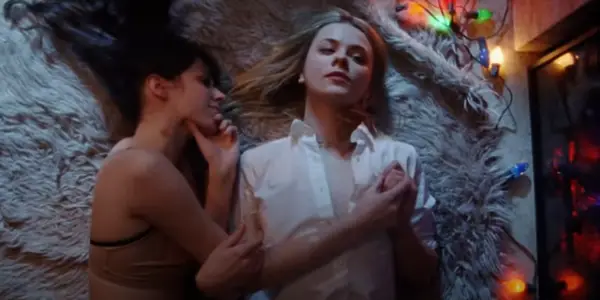
Experimental percussionist and visual artist Eli Keszler created a potently vile and sinister soundtrack for dirtbag-left socialist provocateur Dasha Nekrasova’s debut feature, the head-trip throwback conspiracy horror film The Scary of Sixty-First. Between gliding insanity and John Carpenter–inspired synth cues, Keszler’s soundtrack never has a dull moment, striking a balance among serious horror, Eyes Wide Shut–style political intrigue, and goofy, uncomfortable, sexual tongue-in-cheek schlock.
The film concerns two women (Madeline Quinn and Betsey Brown) who rent a suspiciously cheap apartment and fall down a rabbit hole of possession, tarot cards, and rich pedophiles when an inquisitive stranger (Nekrasova) tells them the place used to be a pedophilia-slash-murder den for Jeffrey Epstein. For all the story’s heavy political baggage and grungy atmosphere, it’s also unapologetically snarky and subversive. The ominous twinkling and nefarious droning Keszler uses is mediated on the OST with dialogue from the film at the beginning of some songs. “I’m not like normal people. I’m obsessed with political struggle,” Nekrasova huskily intones in “Vyvanse Study.”
Rather than the frenzied string madness of Philippe Sarde’s The Tenant score or the creeping choral dread of Krzysztof Komeda’s work on Rosemary’s Baby — both films Scary obviously worships — Keszler lets the film’s mania dictate the music. The synths and intense percussion are the highlights here — on “Research,” early on the album, Keszler hits a jaunty high-school-kids-late-in-the-library rhythm with a more traditional keyboard, catching you off-guard. But there are still the odd reverbed synth notes and warped ghost calls in the background that presage that something terrible is going to happen to these people.
“Tarot Hallucination” uses an organ and a throat-singing sound to convey the dark, Satanic dimensions of the story, while demonic rumbles pair with soft keyboard glitters on “So Royal.” On “Scary Theme” and “Vyvanse Study,” Keszler creates these tense, uncanny, devious keyboard cues that, alongside the propulsive percussion, seem to be dragging our protagonists deeper into the muck and mire of Epstein conspiracies. These seeds all bear fruit in “She Runs,” the penultimate track that ties all the disparate sounds and influences together and all but howls at the moon with a retro, grimy punk kineticism and bloodthirsty fanaticism that define the Sailor Socialism’s maiden voyage into filmmaking.
8. Nathan Johnson, Nightmare Alley

Nathan Johnson is one of my favorite composers working today. Cousin of filmmaker Rian Johnson, he scored most of his work, including the resplendent, warm soundtrack for The Brothers Bloom, the sprawling, jazzy, metronomic score of Looper, and the luxe, staccato manor mystery themes of Knives Out. For Nightmare Alley, Johnson took a break from directing music videos and replaced Alexandre Desplat to score Guillermo Del Toro’s slippery carny-noir spook show, Johnson’s first collaboration with an auteur of Del Toro’s stature.
Nightmare Alley is a hard film to like: It stumbles through its runtime, all seediness and no atmosphere, lots of smoke, and little substance. The fragmented storytelling doesn’t help, either, and the performances never broach the vague archetypes they’re mimicking. But Johnson’s score rises to the occasion where Del Toro’s filmmaking falls short, mixing the dark, slithering insinuation of strings with genuine warmth and empathy for the characters that Del Toro’s script never matches. In some ways, it doesn’t suit the film. I think Johnson may be an optimist and Del Toro a nihilist — at least, as far as Nightmare Alley is concerned — which results in a fascinating dissonance between the score and the actual text it’s supposed to be supporting. But listening to Johnson’s orchestrations, you slip away from the dirty tungstens and anemic blues of Del Toro’s nightmare carnival and begin to imagine that you’re instead watching a much better story unfold.
Just listening to “Open Graves,” I get so much empathy for these terrible, rotten souls, as well as the better ones caught up in their orbits (and jeez, it’s so evocative of The Brothers Bloom!). And with “Grindle’s Ghost,” soundtracking the denouement of Stanton Carlisle (Bradley Cooper)’s final con, I’m hit with the tragedy, horror, clinging hope and overwhelming in-over-his-head-ness that makes the whole final act click into place. Despite such a depressing world, it’s the hope that sells Nightmare Alley. Rather than the stoic, slimy figure of Stan, Johnson seems to model his orchestrations on the ingénue grace of Rooney Mara’s Molly Cahill — the sensitive, lonely piano version of the film’s theme floats with somber elegance, and you get little glimpses of The Brothers Bloom’s grand tragedy between the notes. I wish I loved anything in this world as much as Nathan Johnson loves giving broken characters austere, lonesome piano scores.
7. Dan Deacon, Ascension

The most confusing cry I’ve ever had (recently) was listening to a live recording of Dan Deacon’s “Feel the Lightning,” a deeply resonant song that feels like electrons weightlessly flowing through graphene, or like the ground vibrations, a worm might feel if you stuck a big metal rod in the earth and hit it with a hammer. His film music projects recently — Strawberry Mansion, Ascension, and All Light, Everywhere — continue that atomization, that worm-ification of experimental synth. The only drawback of these scores, frankly, is that they’re not nearly as joyous, magnetic, absurd or individualistic as Deacon’s own work, spread across five albums, but I suppose if they were, they would distract from the image and be less effective soundtracks.
Honestly, his score for Strawberry Mansion might be his best yet, but that’s for next year’s list to suss out. His best for 2021, then, is Ascension, which allows the artist to blend classical orchestration with his trademark voltaic style. Ascension, directed by Jessica Kingdon, concerns the state of labor, manufacturing, and capitalism in modern China, its images feeling ripped out of dreams, devoid of context, perfect little tableaus of the hollow horror of the factory.
Deacon plays with this artificiality. Sometimes his score sounds like an orchestra perpetually warming up before a performance, and other times it’s this synth rhythm reflecting on the monotony of the workers’ factory jobs, their proximity to machine labor, and their lack of worth as individuals helpless to free themselves from the cogs of the giant capitalist machine swallowing the world whole. The repetition, as well as the use of found sound, turns the score into an extension of the factory.
“Factory” sounds like a Fordian assembly line of ticks, pistons, smoke plumes, and buzzes; “Water Slide” brings alien ambiance to the quasi-organic plastic tunnels of a waterpark, and one track is just straight-up the theme from Twin Peaks. “Skeletons,” which scores a scene where sex dolls are constructed, starts with an ocean of brown noise and then adds new instruments as though cobbling together a body itself. If a failed state were going to have a dirge, you couldn’t find a composer better suited than Deacon.
6. Nicholas Britell, Cruella And Don’t Look Up
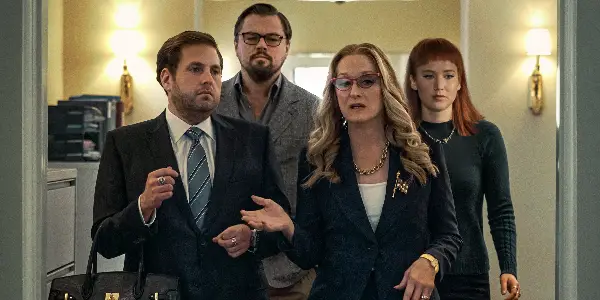
Nicholas Britell has composed some of the greatest film soundtracks of the last 10 years, from 12 Years a Slave to select numbers from Whiplash, which he also produced. He’s collaborated with Barry Jenkins and Adam McKay on all of their films, too, since 2015. In 2021, he scored Cruella and Don’t Look Up, two of his most commercial films yet, and despite that more mainstream vibe, Britell is more unhinged here than on his arthouse projects.
For Cruella, he whips out an inspired a cappella arrangement on “I Think You’re Something,” and he creates a sonic character for Cruella’s punk goth sartorial chic with these revving electric guitar stings and drum cues that don’t have any business going as hard as they do, especially on tracks like “Get It Open / Moths.” Listen to “Surveillance” and tell me that doesn’t make you want to rob a mansion or something.
But it’s the rampaging hurly-burly jazz soundtrack of Don’t Look Up that’s his triumph this year. McKay’s film isn’t a very jazzy, layered, or vibrant work, but Britell brings a sprightliness to a project that otherwise sorely lacks it. And the man dedicates himself — he even does the hold music and BASH ad song!!! (The songs are “On Hold” and “FEMA-BASH Commercial.”)
As the film dials up the nihilism and rage and the apocalypse looms around the second act, Britell’s score gets wilder and darker. “C-5 Galaxy” combines chimes, percussion, basslines, and keyboard to dial up the tension as the core pair of scientists (Leonardo DiCaprio and Jennifer Lawrence) take their discovery of impending Armageddon to the White House, and that’s where the jazz band shows up for the main theme. There’s a Michael Giacchino–on–The Incredibles level of insane throwback 1960s hysterical jazz witchcraft on that number, replete with a trumpet section that seems to scream, “This is the end of the world, and wasn’t it fun while it lasted?” That bottled-up fury uncorks for select numbers like “My Boyfriend Broke Up With Me” and “It’s A Strange Glorious World,” which reprises the main theme, adds a bitching drum bit, some spare piano play, and a jocund little bassline that breaches back up into the central theme.
When the comet appears, on tracks like, um, “The Comet Appears,” Britell holds back, reserves his brass, and goes for mournful, bordering-on-awe-inspired orchestral notes. “The Launch” is similarly orchestral, going for pride, hope, and heroism over despair — the last time any of those emotions rear their heads in Don’t Look Up’s score. I love “Twenty-Four Drones Is Enough,” which combines all of Britell’s melodic sensibilities into one 54-second burst of complex radiance: fountaining futuristic synth notes play against a bold, suspenseful orchestra before the brass and bassline come in, only to be quelled by a military drum. It’s pulsing, heroic and inspiring before neutering itself, and it’s thematically relevant to the anti-government, anti-military aims of Don’t Look Up.
Look, Britell’s a genius, but Cruella and Don’t Look Up prove how versatile and enamored with his craft the composer is: I mean, one’s a gritty goddamn Cruella de Vil origin story, and the other is the dumb comet movie. It feels like it should be composer-for-hire work, but Britell instead gave us two separate, bubbly, giddy scores for projects that probably don’t deserve them. This shit rocks.
5. Nainita Desai, The Reason I Jump
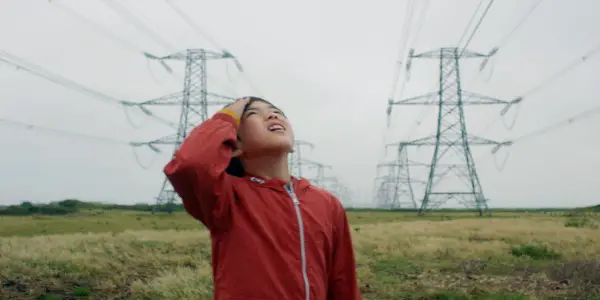
British-Indian composer Nainita Desai started her career as a sound designer before moving onto a whopping 155 scoring credits on films, shorts and series from 1998 to now, many of which were for British TV. Her roots in sound design embolden her score for The Reason I Jump, a documentary about non-speaking individuals with autism.
Adapted from the Japanese biography The Reason I Jump: One Boy’s Voice from the Silence of Autism, written by Naoki Higashida, a nonverbal autistic individual, when he was just 13 years old, the film loosely adapts his story, retaining his words as narration but spotlighting the experiences of five individuals with similar conditions to Higashida. There are no medical explanations, but rather a kind of formal empathy as director Jerry Rothwell tries to communicate through film what it’s like to live with autism.
Desai’s score is integral and invaluable to this end. She not only conjures a breathtaking, vibrant score with elements of fantasy, suspense and wonder, but she also interweaves a soundscape that tries to communicate to neurotypical people what living with autism sounds like the subjects. Found sounds from Nick Ryan’s atmospheric, evocative sound design mix with sung vowels, consonants, and syllables Desai got from singing bits of the book’s original Japanese text. She also combines diegetic sounds and different instruments to create a unique sonic environment for each subject.
With fragmentary song and repetitive string cues that meld into a distant siren sound, “Floating Into Focus” embodies one of the film’s concepts, the idea of how perception is different for individuals with autism. Tracks like “Outside The Flow Of Time” and “Faulty Robot” blend the sound mix into the score, creating subliminal sensory experiences. Another track, “Green Boxes,” adapts one subject, Joss’s, experience of finding musicality in the droning ambiance of electrical boxes. The music is inspired by and serves the subjects, and it’s a deeply empathetic listen.
Desai’s discussed not wanting to over-sentimentalize the music or create heartstring-pulling tracks, but the violin in The Reason I Jump is enough to give you goosebumps. There are plenty of solid, emotional, swelling violin-heavy scores from 2021 — Nine Days, Flee, Foscad, Gift of Fire — but The Reason I Jump has Daniel Pioro, Jonny Greenwood’s violinist, who accompanied the composer on the soundtracks to The Master and Phantom Thread, among other projects. The strings sing in The Reason I Jump on tracks like “Beauty Is In The Detail,” “Permission To Be Alive” and the title track, where they join with a bopping chorus and build to these beautiful syllabic eruptions of song.
4. Daniel Blumberg, The World to Come
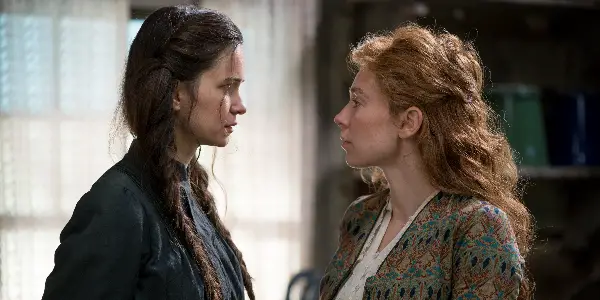
Mona Fastvold‘s lesbian romantic period tragedy The World to Come has one of the saddest film scores of the year, or possibly of any lesbian romantic period tragedy ever. English composer Daniel Blumberg digs at your soul for nearly an hour with stark, lonely pieces to match the film’s austere wintry 1850s New York countryside setting. On “Nellie,” when Abigail (Katherine Waterston) reminisces about her lost daughter, distant cowbells sound almost like Buddhist prayer bells — it reminds me of Honey Boy, which has a phenomenally experimental score from Alex Somers and also features prominent cowbell.
The World to Come is Blumberg’s first film score; previously, he was the lead singer for Cajun Dance Party and lead guitarist for Yuck. The World to Come’s score has none of these influences, of course, which is what makes Blumberg such an exciting, unpredictable artist.
Abigail’s theme is a simple, mournful affair, perfect for long, slow walks across her farm, which she shares with the taciturn Dyer (Casey Affleck). This is a big year for sad clarinets — C’mon C’mon is full of them — but in the theme for Tallie (Vanessa Kirby), Abigail’s eventual secret lover, a violin enters, and the music feels hopeful, but hope through a filter, like light streaming in through a smoky window, catching the dust suspended in the air. (The clarinetists are Yoni Silver, Alex Ward, and celebrated German avant-garde jazz musician Peter Brötzmann.)
Inspired by the film’s simple quietude and its emphasis on small glances and moments that Abigail and Tallie can steal for themselves amid lives dominated by their husbands, Blumberg’s score is balanced and poetic, evoking beauty while never getting too grand for the provincial setting. These songs are tender and aching — listen to “Falling in Love,” with its elegant, wandering, uncertain clarinet, like a fluttering dream headed somewhere unknown, drifting along on violins and an accompanying bass clarinet. The unexpected love blooming and faint hopes of seeing each other again can be felt profoundly in the score, reminding me of the film’s narration, when Waterston compares her lovesick gay heart to “a leaf borne over a rock by rapidly moving water.”
I love the more confident, equally melancholic “First Kiss,” which has some devastating vocalizations toward the end; the more treacherous and chaotic “Tallie Missing”; and the stripped-down, bare “Rooftop.” “Love and Death,” an ominous, heartbroken track, uses cowbells like a death knell, letting the strings take the lead for a scattered, almost improvisational-feeling song that festers like a wound. Blumberg’s score never lets the tragedy drift too far away, and when it does come to the fore, those clarinets have the power to tear you apart.
3. Eiko Ishibashi, Drive My Car
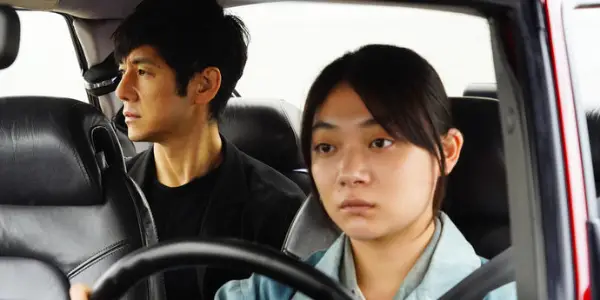
Eiko Ishibashi does it all — she’s a killer keyboard player, drummer, and vibraphonist. Across eight albums, including the score for a 2019 Blade of the Immortal adaptation, she’s demonstrated immense versatility, from pop to noise to modern classical to Drive My Car, for which Ishibashi composed a low-energy, relaxing softcore jazz score, centered around two themes.
Listen to “Drive My Car (Misaki),” which blends car foley noises into the start of a repetitive piano harmony. Over two minutes, Ishibashi introduces subtle variations on that harmony, like poetry, manipulating the verses ever so slightly to produce a lulling exhale of a track. But the simplicity of many of Drive My Car’s best songs is misleading, and she’ll catch you off-guard with a quick percussive start to “Drive My Car (the important thing is to work)” and “We’ll live through the long, long days, and through the long nights (SAAB 900),” mixing these with a dash of piano and droning, almost mechanical, ambient noise.
“(SAAB 900)” even contains sounds of the key turning in the ignition, the seatbelt clicking, the car pulling to a stop, and the car crash that sort of sets the action in motion, using foley on the album to break down the line between film and score and tell the story through music. And the drums! The drums on “(SAAB 900)” are exquisite — how they keep a tempo unlike anything in the film, creating a quick, improvisational pace for the score that juxtaposes the film’s measured, studied narrative.
I get it — jazz and modern classical aren’t everyone’s thing, but give this a listen if you love the film. In her jazz accompaniments, Ishibashi finds characterization in the chords. The unification of car sounds and soothing aura reflects the forces of alienation, melancholy, isolation, and drive that fuel prestigious theater director Yūsuke Kafuku (Hidetoshi Nishijima). The chords in “Drive My Car (The truth, no matter what it is, isn’t that frightening)” feel like a blossoming flower, as he learns to open himself up again to new people and relationships as well as to his past. And in “Drive My Car (Kafuku),” the brass, slight at first but more confident as the song goes on, almost feels like Kafuku forging a bond with his driver, Misaki Watari (Tōko Miura), the instruments uniting for a mournful duet.
Drive My Car is such a peculiarly layered soundtrack that it’s also one of the most disappointing elements of Ryusuke Hamaguchi’s film. Drive My Car must have five minutes of the soundtrack, tops. I don’t even think Hamaguchi uses more than three tracks. But standing on its own, Ishibashi’s score is one of the most refined, somber, contemplative works of the year. It’ll make you rethink your whole life. It’s utterly transportive; it makes me tear up every time I hear it. It enriches the film and lives beyond it. And if you love Ishibashi’s work here, her 2018 album, The Dream My Bones Dream, is a terrific noir-y jazz-noise-classical-depression pop album that will similarly devastate you. Probably better for drives alone, though.
2. Dan Romer, Luca
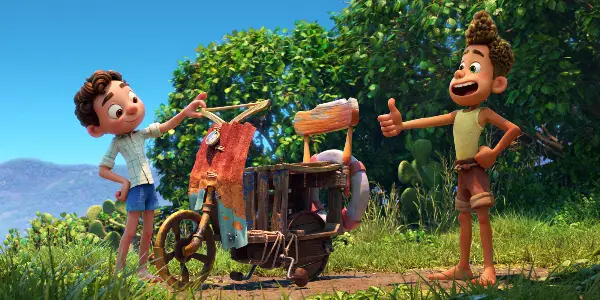
The most heartbreaking and uplifting moments in Luca come courtesy of its score. Who’d have thought that the dude who produced Shawn Mendes’ “Treat You Better” could compose the strongest Pixar score since Up?
Dan Romer’s been busy since launching into film scoring with Beasts of the Southern Wild in 2012 with Benh Zeitlin. From prestige TV (Maniac and Ramy) to other awards contenders (Wendy and Beasts of No Nation) and video games (Far Cry 5), Romer’s career has been prolific and scattered. Away from the fiddles and banjos of his usual Appalachian sound, on Luca, Romer was encouraged to play in Italian sound and instrumentation to flesh out the sleepy town of Portorosso and the uplifting tale of two sea monsters falling in love and being super gay — er, I mean, becoming friends. Definitely no queer subtext here. This totally isn’t a coming-out story.
Romer navigates the undersea world of Luca (Jacob Tremblay) with submerged reverb and distant whale calls against the plucking strings on tracks like “Meet Luca” to make a really genuine, innocent, heartfelt main theme. Director Enrico Cosarosa worked with Romer to make an authentically Italian sound while retaining Romer’s signature. The dreamy, wide-eyed violin-trumpet mix of Beasts of the Southern Wild remains recognizable throughout Luca, particularly in those daydreamy whistling melodies while Luca is still underwater, longing to be where the people are.
With Alberto (Jack Dylan Grazer), the absolute-nightmare gay kid Luca falls for, on tracks like “Walking Is Just Like Swimming,” Romer lets his mandolins pick up some pep, and though the adventurous Alberto usually is paired with energetic, brash, grandiose orchestrations, tracks like “That’s the Dream” and “Take Me, Gravity” dig up the raw, vulnerable kid at the core. Romer plays much of the nylon-stringed guitar and accordion on Luca‘s soundtrack himself.
The closer the kids get to the town of Portorosso, the more Italian the influences on the score until the track “Portorosso” hits and overwhelms you with this lush, romantic Italiana. Pasta! Fishing! Vespas! Meddlesome cats! The summary score reminds me of the seaside town in Kiki’s Delivery Service, whose score similarly swings for a broad Italian sound while knowing when to be wistful or playful.
The climax, set during a pivotal cross-town race, is a masterstroke of composition. Romer starts timidly, tensely, with Luca mustering his courage and embarking alone. From there, the score builds, moving from playful to intense as naturally and winsomely as the film does. It layers all the character themes together, leading to a magnificent few beats of peak drama and choral suspense before Romer builds us back up again, the strings confidently crescendoing to Luca’s big hero moment. There’s so much childlike wonder, so many heroic flourishes to the score’s final tracks that sell those emotional cues. I love how the score climbs for the final track, “Go Find Out for Me,” and just keeps going until it hits a huge orchestral bubble echoing Luca’s theme as the kid embarks on a new adventure. I literally can’t listen to these cues in public — I’ll just start crying.
Honorable Mentions
I can’t stress enough how fruitless it feels to give out props for the best film scores of 2021 when it’s the same year Guilty Gear -Strive- came out. That game’s soundtrack is four hours of high-octane metal-slash-anime-electrofunk skull-slamming from Daisuke Ishiwatari, and no offense to the films on this list, but Ishiwatari’s work is far and away better than most film scores that came out this year. Look, The Power of the Dog has a great main theme! But Jonny Greenwood doesn’t make me want to throw a brick through my neighbor’s window and sprint down the block. If anything, it makes me want to mysteriously ride a horse around a dusty town, which is hardly a vibe and more just a thing that happens in the movie that the score does a good job of evoking. Guilty Gear -Strive-, on the other hand? Every insane character gets their own theme. As if it couldn’t be more badass to beat a crazy doctor demon dude to death with an anchor and a dolphin, Strive lets you do it to the absolutely hardest goddamn guitar riff ever.
Other explosive film scores from 2021 include the soundtracks for Annette, Encanto, and West Side Story, by Sparks; Germaine Franco and Lin-Manuel Miranda; and Leonard Bernstein, respectively. I mean, the new version of Cool is ~definitive~. Besides The Scary of Sixty-First, Clint Mansell’s score for In the Earth is appropriately invasive and unnerving too. Alberto Iglesias’ opening theme for Parallel Mothers is instantly iconic, pulsing and deceptive, and Nick Foster’s score for Misha and the Wolves has some of the most tragic strings work of the year. Keegan DeWitt and Dabney Morris also score a very challenging, difficult film with only church hymns for Procession, and it rocks.
1. Jeymes Samuel, The Harder They Fall
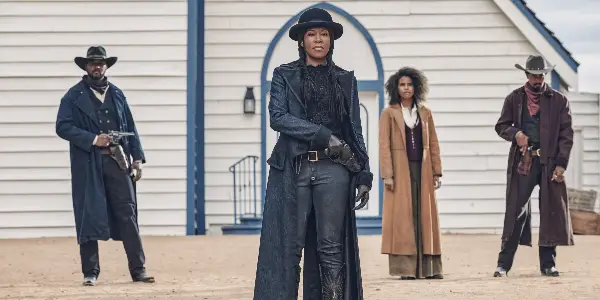
The Harder They Fall, produced, written, directed, and scored by Jeymes Samuel, is a major, major goddamn work. The best neo-Western of the past 20 years, like if Django Unchained had the courage and confidence to shuck all its white characters except for the bit-role villains. The Harder They Fall is overflowing with Black talent, with some of the greatest actors of American film together on-screen, pulling guns on one another and blowing arms off in a film that never pulls its punches. The R&B and rap soundtrack is juxtaposed on the score by gorgeous, soaring orchestrations and tense gun battle medleys.
The Harder They Fall stages a genre intervention, and Samuel’s got the Chamber Orchestra of London behind him to do it. Together, they create tense, rattling drum accompaniment for the bank robbery and shootouts (“It’s A White Town,” “Is That The Right Arm or the Left?”) and triumphant folk strings for the hero beats (“The Return of Nat Love”), as well as these grand tidal orchestral bits for the story’s sweeping narrative arcs, reminiscent of the classical compositions hitched to most legacy Westerns (“Everything You Love Will Burn,” “Bad Karma In The Afterlife”). Haunting choruses underscore, or maybe over-score, the traumatic violence, particularly in the film’s first scene (“Three and Thirty Years”).
The Harder They Fall is also a very lyrical film, operating in a Black gospel musical tradition while melding the songs with the strings, brass and dangerous thematic portent one associates with the Western. The Fisk Jubilee Singers, a spiritual singing ensemble from Fisk University, perform “Do Unto Others / Ride Out” and a rendition of “Three and Thirty Years,” reinforcing the religious dimensions of the story while providing an acoustic counter to the film’s heavy use of R&B and rap. The score also interweaves tracks sung by the cast— or, well, I think Zazie Beetz does her own singing, on “The Jim Crow Count.” Jonathan Majors as our hero, Nat Love, sings “Away With The Wind She Goes.”
Samuel initially made it big as a grunge alternative rock and R&B artist, The Bullitts, with one album, They Die By Dawn & Other Short Stories…, the eponymous track of which features so many twanging guitars, whistle cues and spaghetti Western riffs that you’d swear The Harder They Fall was always a passion project for him. He also directed They Die By Dawn, a similarly stacked-Black-cast cowboy film from 2013, which now feels like a dry run for this project.
The swagger and verve of The Harder They Fall’s score are unlike anything else that has come out in 2021. Listen to “Ride Out (Part 2),” with its unique repurposing of traditional instruments with brass lines and vocalizations. Or “Showdown / Shootout,” which starts with a rattlesnake sting, evolves into drums and violins, and finally explodes into violence with thrilling percussion quakes and bombastic horns that feel like they riff on Zimmer while making his “bwahhhs” new and fresh. Every corner of Samuel’s Western is tightly controlled while feeling like anything can happen, and so much of that precision and unpredictability comes from his masterwork of a score.
What are some of your favorite scores from 2021? Comment below and let us know!
Does content like this matter to you?
Become a Member and support film journalism. Unlock access to all of Film Inquiry`s great articles. Join a community of like-minded readers who are passionate about cinema - get access to our private members Network, give back to independent filmmakers, and more.
Film critic, Ithaca College graduate, University of St Andrews masters student, head of the "Paddington 2" fan club.













